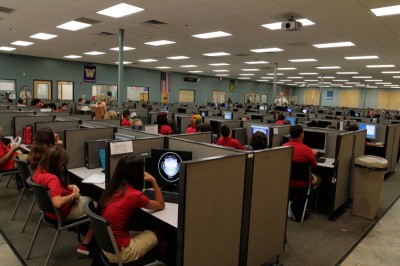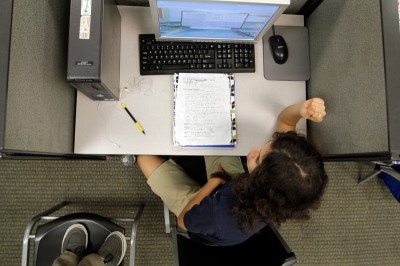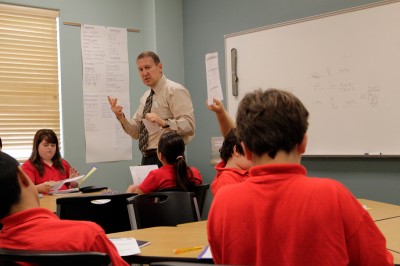Blended Learning, Charter, Domestic, Feature, K-12, Required, Technology - Written by Wired Academic on Friday, September 28, 2012 6:00 - 0 Comments
Education Nation: The Corporatized Charter School In Arizona Called “Carpe Diem”
Dean of students Chet Crain delivering his ritual morning welcome and message to the students of Carpe Diem. (Photo by Nick Pandolfo)
By Nick Pandolfo, The Hechinger Report
YUMA, Ariz. — Carpe Diem Collegiate High School and Middle School looks more like an office or call center than a school.
Over 200 cubicles — not desks — fill this modern version of a one-room schoolhouse on a quiet side street here in Yuma, a desert city near the Mexican and California borders. All students wear uniforms and have a cubicle, with their own computer, which they decorate with sketches or band stickers instead of a typical office worker’s family photos.
Carpe Diem is trying to upend the way students are taught. In just four days of instruction a week — there’s no school on Fridays — Carpe Diem’s five teachers and four teachers’ aides supplement the concepts their 226 students have learned through a computer program. Teachers also monitor student progress through the program, which calculates grades in real time, zeroing in on the areas in which students are struggling.
“We’re going against hundreds of years of ‘That’s the way it’s always been done,’ ” says Chet Crain, the school’s dean of students.
And it seems to be working. Carpe Diem’s math and reading scores on the Arizona Instrument to Measure Standards for every level from sixth to 12th grade outpace the average for Arizona schools. And the school is achieving these results with a student population that closely mirrors the demographics of other schools in the state, even though 46 percent of Carpe Diem students received free or reduced-price lunch during the 2011-12 school year, according to Carpe Diem COO Ryan Hackman, compared to an average of 75 percent in other Yuma schools. Carpe Diem’s success has caught the attention of education reformers across the country, and this fall the first of what could ultimately be six new schools opened in Indianapolis.
Because Carpe Diem is a charter school — publicly funded but privately run — there is more freedom for educators to create their own curriculum, model and vision, which Crain says is critical to the success and development of the model.
“We can turn on a dime. And not only on a dime, sometimes it’s on less than a dime,” Crain says.
Charter schools in Arizona receive about $1,700 less in per-pupil funding each year than district schools, according to a 2012 progress report from the Arizona Department of Education. But because Carpe Diem’s model requires fewer teachers than traditional public schools, it’s able to spend on operations only about $5,300 of the roughly $6,300 the school receives per student, according to Hackman. Most of the rest goes toward paying off the bond on the $2.6 million facility, which was built in 2006.
Carpe Diem is at the forefront of a movement called “blended learning,” where students receive some of their instruction online and some of it face to face. The amount of time spent online versus with traditional classroom teachers varies depending on the model, of which there are many.
RESULTS
- Since switching to their blended model in the 2005-2006 school year, Carpe Diem’s test scores have risen dramatically.
- In 2010, they scored first in the county in math, with 100 percent of their sixth graders passing the Arizona Instrument to Measure Standards (AIMS), the standardized exams used in Arizona.
- Ryan Hackmann, chief operating officer, said they’re trying to raise their seventh grade writing scores, which – while better than the state average of 53 percent – are still low at 58 percent.
In Carpe Diem’s case, students spend more than half of each school day in their cubicles, headphones plugged in, learning from an online curriculum provided by the company Education2020 (e2020), which delivers all of the core content in math, language arts, science and social studies. Four times a day, small groups of students participate in subject-specific workshops with teachers, who lead lessons that build on the e2020 curriculum and who get students to think critically about what they’re learning and apply it to class projects.
Teachers at Carpe Diem instruct students in every grade, which they say allows them over time to get to know students’ strengths and weaknesses intimately.
“It’s a lot of responsibility, but the key is that except for the new students, I know all of my students from grade six up to grade 12,” says Douglas Erlemann, Carpe Diem’s lone math teacher.
The school has its critics. Professor Michael Barbour, of Wayne State University in Detroit, says that Carpe Diem’s online curriculum is specifically designed to get kids to do well on standardized tests and graduate from high school, which it does well, but that it falls short on fostering critical thinking skills.
“The nature of the curriculum and the way in which they try and provide support to the student, it’s designed to get these students through the system,” says Barbour. “It’s designed to achieve that false belief that no child should be left behind.”
Ryan Hackmann, Carpe Diem’s chief operating officer, says that while teachers try to create more projects that promote critical thinking, it’s an area they are still strengthening as teachers adjust to their new roles in the Carpe Diem model.
Interviews with teachers, administrators and dozens of students about the type of learner who thrives at Carpe Diem all contained variations of adjectives like “self-motivated” and “hard-working.” Crain, Hackmann and teachers say that Carpe Diem isn’t for every student — and that students who aren’t dedicated and comfortable taking some control of their education might not do well and end up leaving the school. Perhaps for this reason, Carpe Diem tends to lose a higher percentage of its students each year than district schools do.
Most students say they like learning from computers and enjoy the opportunity to move at their own pace. The majority say they receive as much or more attention from their teachers at Carpe Diem as they did in their previous schools.
By design, the e2020 curriculum allows students at Carpe Diem to move ahead of their peers. And some, like 14-year-old Bineetha Aluri, are grade levels ahead. Aluri, who wants to be a neurologist, has already taken five college classes at Arizona Western College, a public community college in Yuma. In addition to studying calculus there, she receives elective credit at Carpe Diem for being a teacher’s assistant in Mr. Erlemann’s math class. She’ll likely finish high school by the end of her junior year.
“My parents thought this would be better for me, and it is,” says Aluri, “because I can actually work faster than other people and I don’t have to stay at the same pace that everyone else is [at].”
But for all the success that Carpe Diem has enjoyed so far at its Yuma campus, its future remains uncertain. The bigger question of whether it can achieve success in other cities will be partly answered this year in Indianapolis, as students and teachers there try to seize the day.
This story was produced by The Hechinger Report, a non-profit, independent journalism organization housed at Columbia University in New York City. This story is part of a series written in collaboration with NBC for the annual Education Nation summit. Check out an interactive version of the story. Visit NBC’s Education Nation page
Campus Buzz
We welcome Tips & Pitches
Latest WA Original Features
-
“Instreamia” Shakes Loose Moss By Launching Spanish Language Mini-MOOC
-
Jörn Loviscach: A German Math Teaching Sensation Emerges On YouTube & Udacity
-
Open University Enters Battle Of The MOOCs, Launches “FutureLearn”
-
Alvaro Salas As A Case Study In Crowd-Funding An Ivy-League Education
-
Jonathan Mugan: How To Build A Free Computer Within A Computer For Your Child
Paul Glader, Managing Editor
@paulglader
Eleni Glader, Policy Editor
Elbert Chu, Innovation Editor
@elbertchu
Biagio Arobba, Web Developer
@barobba
Contributors:
Michael B. Horn
@michaelbhorn
Derek Reed
@derekreed
Annie Murphy Paul
@AnnieMurphyPaul
Frank Catalano
@FrankCatalano
Ryan Craig
@UniVenturesFund
Jonathan Mugan
@JMugan
Terry Heick
@TeachThought
Alison Anderson
@tedrosececi
Ravi Kumar
@ravinepal

The Pulitzer Prize winning investigation newsroom digs into for-profit education.
-
Most Viewed
- Inside Ashford University: A former staffer talks to WiredAcademic
- Infographic: A History Of Information Organization From Stone-Age To Google
- Davos: 12-Year-Old Pakistani Prodigy Girl Talks About Her Online Learning
- Open University Enters Battle Of The MOOCs, Launches "FutureLearn"
- Pearson Llc + Google Expands LMS Business With "OpenClass" System
-
MARKET INTRADAY SNAPSHOT
- Education & Tech Companies We Follow
| APEI | 40.20 |  0.00 0.00 |  +0.00% +0.00% | ||
| APOL | 19.01 |  0.00 0.00 |  +0.00% +0.00% | ||
| AAPL | 460.16 |  0.00 0.00 |  +0.00% +0.00% | ||
| BPI | 10.74 |  0.00 0.00 |  +0.00% +0.00% | ||
| CAST | 0.11 |  0.00 0.00 |  +0.00% +0.00% | ||
| CECO | 4.08 |  0.00 0.00 |  +0.00% +0.00% | ||
| COCO | 2.40 |  0.00 0.00 |  +0.00% +0.00% | ||
| CPLA | 32.03 |  0.00 0.00 |  +0.00% +0.00% | ||
| DV | 30.69 |  0.00 0.00 |  +0.00% +0.00% | ||
| EDMC | 4.03 |  0.00 0.00 |  +0.00% +0.00% | ||
| ESI | 18.34 |  0.00 0.00 |  +0.00% +0.00% | ||
| GOOG | 792.89 |  0.00 0.00 |  +0.00% +0.00% | ||
| LINC | 6.20 |  0.00 0.00 |  +0.00% +0.00% | ||
| LOPE | 25.03 |  0.00 0.00 |  +0.00% +0.00% | ||
| PEDH | 0.45 |  0.00 0.00 |  +0.00% +0.00% | ||
| PSO | 18.51 |  0.00 0.00 |  +0.00% +0.00% | ||
| SABA | 8.61 |  0.00 0.00 |  +0.00% +0.00% | ||
| SCHL | 30.87 |  0.00 0.00 |  +0.00% +0.00% | ||
| STRA | 51.95 |  0.00 0.00 |  +0.00% +0.00% | ||
| WPO | 414.41 |  0.00 0.00 |  +0.00% +0.00% |
Domestic, For-Profit, Gainful Employment, Infographics, Personalized Learning, Private, Public, Required, Universities & Colleges - Jan 31, 2013 6:09 - 0 Comments
Infographic: To Get A Degree Or Not To Get A Degree? Here Is An Answer
More In For-Profit
- Ryan Craig: American Clampdown Forcing Forlorn For-Profit Colleges To Look Abroad
- How For-Profit Colleges Major In Marketing & Fail Education
- Infographic: A Graphical Profile Of Today’s Online College Student
- Infographic: A Comparison Of For-Profits v. Non-Profit Online College Data
- Opinion: How “Shareholder Value” Is Destroying For-Profit, Career Colleges
Cost of Education Domestic Education Quality Ethics For-Profit Friend, Fraud, or Fishy Gainful Employment Graduation Rates Legislation Minorities Opinion Recruitment Regulatory Required Retention Rates Student Loans Universities & Colleges
MOOCs, Required, Technology - Feb 16, 2013 10:04 - 1 Comment
MOOC Monitor: Must Reads This Week
More In Technology
- Infographic: Rise of the MOOCs
- Smart Cities Part II: Why DC Is The Planetary Hub Of Online Learning
- Five Questions: Polling EdTech Startup UnderstoodIt’s Liam Kaufman
- Infographic: The Future of Higher Education
- Anne Collier: Study Shows eBooks Gaining Larger Share & Boosting Overall Reading Habits
Domestic K-12 Parents Reading / Literature Required Technology
Cost of Education, Domestic, Early Childhood Education, Education Quality, Friend, Fraud, or Fishy, Legislation, Minorities, Parents, Public, Required - Feb 18, 2013 4:59 - 0 Comments
Important Early Questions Over Obama’s Early Childhood Program Ambitions
More In Friend, Fraud, or Fishy
- Should For-Profit Companies Manage K-12 Schools? A Skeptical Review
- A Letter To Sen. Tom Harkin About For-Profit Charter Schools
- Ryan Craig: American Clampdown Forcing Forlorn For-Profit Colleges To Look Abroad
- Opinion: The Problem With Deceptive Degree Aggregators In The Search For Online Courses & Degrees
- How For-Profit Colleges Major In Marketing & Fail Education
Domestic Education Quality Ethics For-Profit Friend, Fraud, or Fishy Graduation Rates Minorities Recruitment Required Retention Rates Universities & Colleges





Leave a Reply